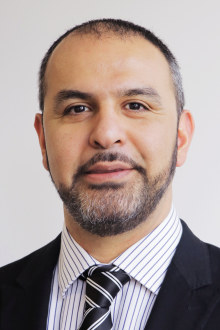Skibeli emphasises the role of portfolio managers in maximising uncorrelated insights from their global research platform.
For JGLO, the focus is always on finding the most attractively valued stocks within each sector. “We then seek to build an overall portfolio with greater EPS growth than the benchmark, greater cash flow generation capability, but overall similar or lower valuation,” he says.

Helge Skibeli, portfolio manager within the J.P. Morgan Asset Management International Equity Group.
The research process Skibeli follows is designed to be effective, sustainable, and repeatable.
“This is due to superior global research insights from an experienced team, a globally consistent research approach proven over time, and the collaboration between analysts and portfolio managers focused on investment results,” he says.
Hamilton Reiner, CIO of US Core and portfolio manager for JEGA, also underscores the importance of fundamental research in stock selection.
The JEGA ETF, JPMorgan Global Equity Premium Income Complex ETF, aims to seek consistent monthly income but at a lower risk than the index. This is done by selecting a portfolio of defensive global equity names to give you that conservative exposure, with the added benefit of income through dividends and options premium.

Hamilton Reiner, CIO of US Core and portfolio manager for J.P. Morgan’s JEGA ETF.
Reiner says that the role of the portfolio management team is to distil these insights to the portfolio level. In JEGA, the underlying equity portfolio construction focuses on maximising exposure to analysts’ insights while maintaining an index-like profile in terms of region, sector, and style.
“At the security level, we take many small active positions based on our fundamental research, overweighting attractive names and underweighting unattractive ones,” says Reiner.
“Idiosyncratic risk, spread across hundreds of names, can be more consistent if the research platform is robust and risk management focuses on rewarded risk and minimises unrewarded risk.
“During a bull market, we may forgo a portion of the upside, but the income will be broadly consistent. In range bound markets we will still be delivering on growth and income, but in volatile markets, like what we have experienced recently, then this is where JEGA shines.”
Investors looking for core global equities exposure have also started to look towards Research Enhanced Indexation (REI) strategies, seeking to get the best of both worlds – active stock selection with passive-like index exposure, says portfolio manager for the JREG ETF Piera Elisa Grassi.
“Most enhanced managers use a quant approach to alpha, which makes J.P. Morgan unique in this space where they use fundamental insights to construct the REI portfolios by leveraging the size and scale of their research platform,” says Grassi.

Portfolio manager for the JREG ETF Piera Elisa Grassi.
“This fundamental research-driven approach allows the portfolio manager to make small overweights and underweights on stocks they like vs stock they don’t like, but still keeping the portfolio sector, style and region neutral.”
The JREG ETF, JPMorgan Global Research Enhanced Index Equity Active ETF, provides opportunities for active global equity exposure at low fees.
In Australia, where market cap constraints can limit investment opportunities, these global strategies provide a way to tap into more diverse and potentially lucrative markets.
Grassi emphasises the balance between active stock selection and maintaining low tracking error, a crucial aspect in navigating global equities.
Danial Moradi, portfolio manager of listed products at Lonsec Investment Solutions, says ETFs offer a way for Australians to gain exposure to global markets.
Concentrated risk in the Australian market
Despite having over 2000 companies listed on the Australian Securities Exchange (ASX), the market’s apparent diversity is deceptive.
“The Australian equity market is dominated by two sectors, materials and financials, representing over half the market capitalisation of the entire ASX.”
Combined, these two sectors have a market capitalisation of $1.3 trillion, equivalent to over half the ASX’s market capitalisation. The concentration risk becomes even more pronounced considering that most of this value is driven by just eight companies in banking and iron ore mining.
This over-reliance on a few key players means that the performance of Australian investment portfolios is closely tied to the fortunes of banks and mining companies.
The risks associated with such a concentrated market are considerable, says Moradi.
Major indices, such as the S&P/ASX 200 index, are market cap-weighted, meaning a narrow group of businesses significantly impacts overall market returns. This concentration poses a threat to domestic investors, who may find their portfolios underperforming relative to more diversified international markets.
“The last three years have been a great example of the dangers of having too much home country bias towards Australian equities in your investment portfolio,” says Moradi.
Over the past three financial years, the S&P/ASX 200 index has delivered an annualised return of 6.4 per cent per annum. In contrast, international equities, as measured by the MSCI World ex-Australia Index, have delivered total returns of 11.2 per cent per annum over the same period. This stark difference underscores the potential downside of investing in a highly concentrated market like Australia.
Another significant risk of focusing solely on the Australian market is the implied overexposure to a single economy, says Moradi.
“The drivers of Australia’s economy are unique and can diverge significantly from those of other countries,” he says.
“Spreading investments across various regions might help reduce risk in the event of a prolonged downturn in the Australian economy.”
Selecting international stocks
Many Australian investors may find the prospect of researching and selecting international stocks daunting, says Moradi.
The sheer number of global companies, coupled with the challenges of accessing reliable information, particularly from non-English speaking countries, can be overwhelming. However, there are strategies to navigate this complexity.

Danial Moradi, portfolio manager of listed products at Lonsec Investment Solutions.
“There are two strategies Australian investors can use to invest in international shares: either directly selecting which global companies to invest in, or indirectly through managed products like managed funds or exchange traded funds,” says Moradi.
While direct selection offers control, it requires extensive research and a deep understanding of international markets.
This is where managed funds and professionally managed ETFs come into play. These products allow investors to gain exposure to global stocks without the burden of selecting individual companies.
“Instead of focusing on which particular company to invest in, investors can use a blend of products to gain access to different global stocks and investment styles,” says Moradi.
ETFs, in particular, offer a cost-effective and convenient way to achieve diversification.
Global sectors for diversification
Diversification is a key strategy for achieving superior risk-adjusted returns. By investing across different countries, sectors, and businesses, investors can minimise the overlap in their portfolios. Typical global equity benchmarks represent investments in over 20 countries and 11 different industry groups, ranging from information technology to healthcare and real estate.
“Portfolios constructed of investments with different returns characteristics typically tend to deliver superior risk-adjusted returns for investors,” says Moradi.
Sectors such as information technology, which are underrepresented in Australia, form a much larger part of the equity markets in the US and emerging markets. This provides investors with exposure to high-quality growth companies like Apple and Microsoft in the US, Samsung Electronics in South Korea, and Alibaba Group in China.
“The addition of global equities within a well-balanced portfolio may act as a source of long-term growth, diversification, and sit within the growth component of such a portfolio,” says Moradi.
To learn more, please visit J.P. Morgan.





